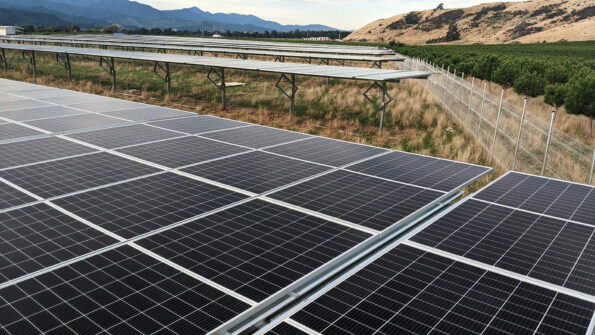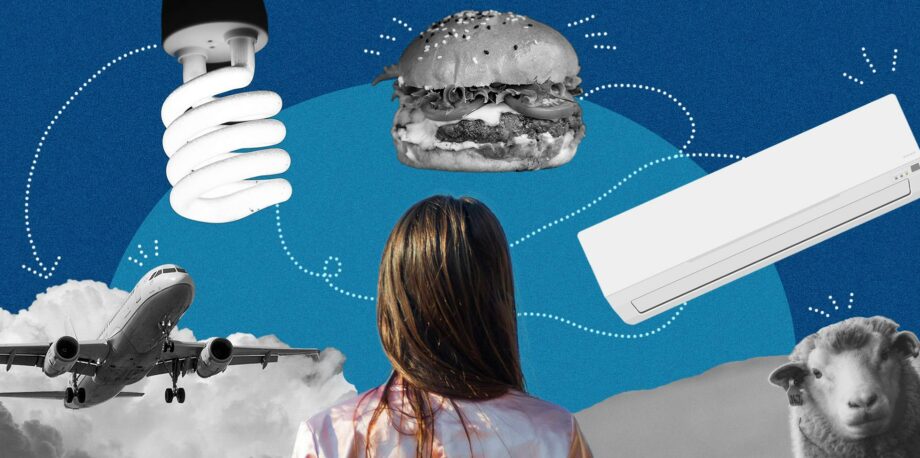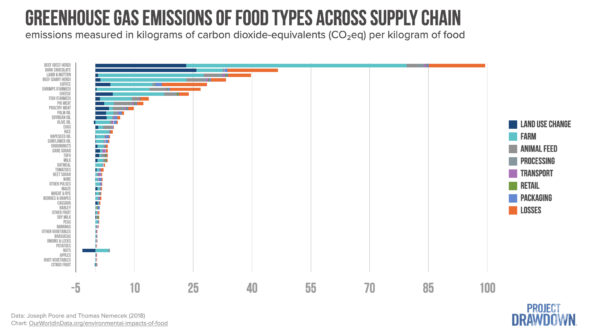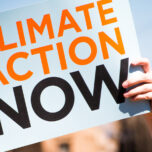May 22, 2024 — Editor’s note: This op-ed originally appeared at Project Drawdown and is printed here with permission.
When I tell someone I lead a climate change nonprofit, one of the most common questions I get is: What can I do to reduce my carbon footprint?
It’s a fair and important question. After all, Project Drawdown and RARE, among others, have shown that about one-third of the solutions needed to stop climate change are best implemented at the household or family level.
Moreover, every individual action results in unseen ripples that influence the larger systems of which we are all a part. For instance, by switching to an electric vehicle or installing solar panels you not only reduce your own carbon emissions but also influence those around you to do the same and send a signal to politicians and the market that what’s good for the planet is also good for their politics or their bottom line.
You’ll sometimes hear from environmentalists that we need “system change” at the level of policy and business, not personal change, to address the climate crisis. While it’s true that systemic change is necessary and we should continue to be wary of efforts from the fossil-fuel industry and other bad-faith actors to shift blame for the climate crisis from themselves to consumers, we cannot dismiss the importance of individual climate action. We need system change, but personal actions are part of the system.
But what actions matter most?
There are dozens of lists online that attempt to tell you just that (we have even published them in the past at Project Drawdown). Despite being well-intentioned, almost all of these lists fall short for the same reason: They are one-size-fits-all while humans are not.
Without knowing who you are, how you live, or what you are unable or unwilling to do, I cannot possibly provide the best climate solution any more than a waiter without consultation could pick your favorite meal off a menu at a restaurant. What I can do, however, and what I attempt to do below, is point out parts of your life where it’s likely that you could be living more sustainably and give you the tools to take stock and take action.
How You Eat
What we eat and how we grow it has a major impact on the environment. Agriculture — and animal agriculture, in particular — shapes the landscapes, water resources, ecosystems and climate we depend on. In all, agriculture uses about 37% of our planet’s land, drives 70% of our freshwater use, and produces about one-quarter to one-third of our greenhouse gas emissions.
Almost as important as the food we eat, however, is the food we waste. Globally, roughly 30-40% of the food we produce is never eaten and is lost somewhere between farm and fork. Not only does this waste all of the embedded carbon emissions — those emitted to grow, ship and store the food — but when that food waste breaks down in landfills it releases methane, a potent greenhouse gas that is a major contributor to climate change.
So what are some ways to reduce the impact of our food choices?
Take Stock
- Keep a food journal. For one week, track what you eat and what you waste to better understand your habits. What foods do you eat most? Are you cooking too much at a time? Are you actually eating those leftovers, or do you toss them out?
- Calculate your food footprint. Check out this handy chart from Our World in Data to get a sense of where your diet-driven carbon is coming from.
Take Action
- Make smaller portions. If you’re always saving leftovers but rarely eating them, try cooking smaller portions instead.
- Be wary of sell-by dates. Always inspect food carefully for safety, but just because it’s past the sell-by date doesn’t mean it’s actually gone off.
- Shift to a healthier, plant-rich diet. On this, the science is abundantly clear. Meat and dairy are a major source of our diet-related emissions — especially in countries like the U.S. Going meatless even a few days a week, or substituting red meat with white meat, can dramatically reduce your impact on the environment.
How You Power Up
Generating electricity from coal and natural gas accounts for roughly 20-25% of the world’s greenhouse gas emissions. What percentage of your emissions it makes up will vary depending on where you live, how your electricity is produced, how your house is built and so on. But there are almost always ways you can reduce your emissions from electricity generation by being more efficient.
Take Stock
- Look at your provider. Do you know where your electricity is really coming from? As a customer, you have the right to know. Contact your provider and ask for a breakdown showing how much of your electricity generation is from fossil fuels and how much is from renewables. And while you have them on the phone, ask them if they have any plans to expand their use of renewables to let them know it’s top of mind.
- Track your energy use. Do you know where your electricity is really going? Make a list of all of the devices and appliances you power, being sure to check whether or not they are as efficient as they could be.

Photo by Thomas Coker / Unsplash
Take Action
- Update those light bulbs. Incandescent light bulbs are an energy-wasting relic of the past, but you might be surprised to find a few of them still in use around your home. Swapping those out for LED bulbs — which use roughly 75% less energy — is a quick and inexpensive way to cut your electricity emissions.
- Upgrade your appliances. Few people are thrilled when they have to buy a new appliance, but if your refrigerator is burnt out or your washing machine has wasted away you can save both money and emissions by getting an Energy Star®-certified replacement. Before buying, be sure to check if your local utility company or government has any rebates or other incentives for upgrading to healthier, energy-efficient appliances. Check Energy Star for great information about efficient appliances.
How You Travel
Depending on where you live and how you get around, transportation could very well be your largest source of direct greenhouse gas emissions.
Take Stock
- Determine your driving habits. If you have a personal vehicle — especially if it is gas-powered — track where you are going in an average week.
- Look around for driving alternatives. Take a moment to look into work-from-home options, public transportation offerings bike lanes, and other ways of getting around in your area. Are there any less carbon-intensive options that correspond with a trip you frequently make? For when you absolutely need a car, see if your city offers any sort of electric car-share program and maybe go with that instead of a polluting, fossil-fueled vehicle.

Photo by 勻蔚 / Unsplash
Take Action
- Drive less. No matter what kind of vehicle you drive, driving less is one of the best ways to reduce your greenhouse gas emissions. For those who are able, biking or walking is almost always the best option.
- Drive cleaner. When purchasing or leasing a car, choose the most efficient option that fits your needs. Explore local or national incentives for electric and hybrid vehicles that can make them more affordable. If an electric or hybrid vehicle is still not within your means, purchase or lease a car that is as fuel-efficient as possible to save money on gas while reducing pollution and greenhouse gas emissions.
- Drive better. Be sure to conduct regular maintenance on your gas-powered vehicle and keep your tires properly inflated to maximize fuel economy and minimize emissions. Even changing how you drive, such as slowly accelerating and braking, can improve efficiency.
- Fly less. For those who are frequent flyers, less air travel can be a powerful climate action. In particular, if you find yourself flying a lot for work, ask whether such trips are really necessary or if teleconferencing is a viable option.
How You Heat or Cool
Heating and cooling living spaces — and making household hot water — takes a lot of energy. For many people, especially those with older homes, this may be your single largest source of emissions — and one of your biggest monthly bills. Luckily, small changes in how we heat and cool our homes can greatly reduce our emissions.
Take Stock
- Conduct an energy audit. Audits can uncover all the ways to retrofit or update your home to increase heating and cooling efficiency. Better still, audits are often offered at little or no cost by local utility companies or government agencies.
- Analyze your utility bills. Look for any usual — or unusual — changes month to month, season by season, and year to year. In particular, watch for big spikes in electricity use (measured in kilowatt-hours, kWh) and natural gas use (usually measured in therms). A typical house in the United States uses roughly 600-1,000 kWh a month, and maybe 500-1,000 therms a year of natural gas. How does your house stack up?
Take Action
- Smarten your thermostat. Programmable thermostats can cut heating and cooling costs by ensuring you never unnecessarily heat or cool your home when it’s empty or when you’re sleeping.
- Avoid over air-conditioning. Use windows, shade trees and attic fans to beat the heat when possible. Consider replacing older, inefficient air conditioning units with more effective and environmentally friendly alternatives such as a heat pump.
- Sweat the small stuff. Weatherizing your home doesn’t have to be costly. Grab a tube of caulk to plug window gaps, door leaks or other openings that are reducing your heating and cooling efficiency. Better insulating your attic and/or basement is also a cheap and easy way to reduce emissions.
- Use less hot water. When possible, using cold water instead of hot water is a great way to save money and emissions. This can be done relatively easily by installing low-flow faucets and showerheads, washing your clothes in cold water, and setting your water heater no higher than 120°F.
These are just a handful of many aspects of your life where you can take climate action. Whether or not they are the most impactful ones you can take depends on who you are, where you live and what you already do.
Ultimately, the most important and effective individual actions — whether a one-time affair, such as switching your bank; something you do a couple of times per year, like voting for an environmentally focused candidate; or something you do day in and day out, like being vegetarian — are those you are willing and able to do to create a healthier, more sustainable planet. You don’t need a random list you found on the Internet; you need to take stock and take action.
So the next time I’m asked what the best thing any one person can do for the planet, my response will be: You tell me.
Editor’s note: From 2008 and 2014, Jonathan Foley was the founding director of the Institute on the Environment (IonE) at the University of Minnesota, which publishes Ensia. You can read his previous writing in Ensia here.
Related Posts
Ensia shares solutions-focused stories free of charge through our online magazine and partner media. That means audiences around the world have ready access to stories that can — and do — help them shape a better future. If you value our work, please show your support today.
Yes, I'll support Ensia!




